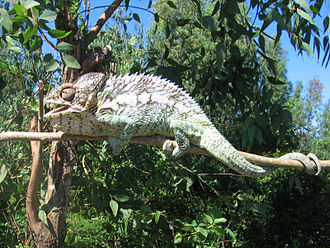Chameleons or chamaeleons (family Chamaeleonidae) are a distinctive and highly specialized clade of Old World lizards with 202 species described as of June 2015. The members of this family are most known for their distinct range of colors as they are able to shift in different hues and brightness. Because of the large number of species in their family, there is a large variability in their ability to change color. For some, it is more of a shift of brightness (shades of brown) whereas others it is a plethora of combinations of colors (reds, yellows, greens, and blues).
The family Chamaeleonidae was divided into two subfamilies, Brookesiinae and Chamaeleoninae, by Klaver and Böhme in 1986. Under this classification, Brookesiinae included the genera Brookesia and Rhampholeon, as well as the genera later split off from them (Palleon and Rieppeleon), while Chamaeleoninae included the genera Bradypodion, Calumma, Chamaeleo, Furcifer and Trioceros, as well as the genera later split off from them (Archaius, Nadzikambia and Kinyongia). Since that time, however, the validity of this subfamily designation has been the subject of much debate, although most phylogenetic studies support the notion that the pygmy chameleons of the subfamily Brookesiinae are not a monophyletic group.
Some chameleon species are able to change their skin coloration. Different chameleon species are able to vary their coloration and pattern through combinations of pink, blue, red, orange, green, black, brown, light blue, yellow, turquoise, and purple. Chameleon skin has a superficial layer which contains pigments, and under the layer are cells with very small (nanoscale) guanine crystals. Chameleons change color by "actively tuning the photonic response of a lattice of small guanine nanocrystals in the s-iridophores". This tuning, by an unknown molecular mechanism, changes the wavelength of light reflected off the crystals which changes the color of the skin. The color change was duplicated ex vivo by modifying the osmolarity of pieces of white skin.
Colour change in chameleons has functions in camouflage, but most commonly in social signaling and in reactions to temperature and other conditions. The relative importance of these functions varies with the circumstances, as well as the species. Colour change signals a chameleon's physiological condition and intentions to other chameleons. Because chameleons are ectothermic, another reason why they change colour is to regulate their body temperatures, either to a darker colour to absorb light and heat to raise their temperature, or to a lighter colour to reflect light and heat, thereby either stabilizing or lowering their body temperature. Chameleons tend to show brighter colours when displaying aggression to other chameleons, and darker colours when they submit or "give up". Some species, particularly those of Madagascar and some African genera in rainforest habitats, have blue fluorescence in their skull tubercles, deriving from bones and possibly serving a signaling role.
The oldest described chameleon is Anqingosaurus brevicephalus from the Middle Paleocene (about 58.7–61.7 mya) of China. Other chameleon fossils include Chamaeleo caroliquarti from the Lower Miocene (about 13–23 mya) of the Czech Republic and Germany, and Chamaeleo intermediate from the Upper Miocene (about 5–13 mya) of Kenya.
The chameleons are probably far older than that, perhaps sharing a common ancestor with iguanids and agamids more than 100 mya (agamids being more closely related). Since fossils have been found in Africa, Europe, and Asia, chameleons were certainly once more widespread than they are today.
Although nearly half of all chameleon species today live in Madagascar, this offers no basis for speculation that chameleons might originate from there. In fact, it has recently been shown that chameleons most likely originated in mainland Africa. It appears there were two distinct oceanic migrations from the mainland to Madagascar. The diverse speciation of chameleons has been theorized to have directly reflected the increase in open habitats (savannah, grassland, and heathland) that accompanied the Oligocene period. Monophyly of the family is supported by several studies.
Chameleons have the most distinctive eyes of any reptile. The upper and lower eyelids are joined, with only a pinhole large enough for the pupil to see through. Each eye can pivot and focus independently, allowing the chameleon to observe two different objects simultaneously. This gives them a full 360-degree arc of vision around their bodies. Prey is located using monocular depth perception, not stereopsis. Chameleons have very good eyesight for reptiles, letting them see small insects from a 5–10 meter distance.[citation needed] In fact, chameleons have the highest magnification (per size) of any vertebrate.
Like snakes, chameleons do not have an outer or a middle ear, so there is neither an ear-opening nor an eardrum. However, chameleons are not deaf: they can detect sound frequencies in the range of 200–600 Hz.
Chameleons can see in both visible and ultraviolet light. Chameleons exposed to ultraviolet light show increased social behavior and activity levels, are more inclined to bask and feed, and are also more likely to reproduce, as it has a positive effect on the pineal gland.
